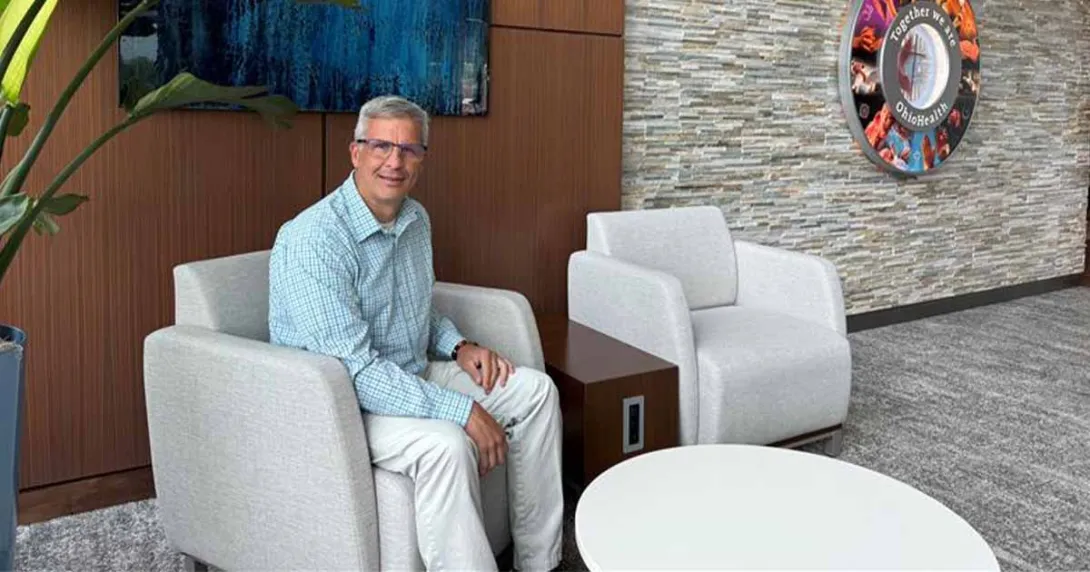
OhioHealth is a Columbus-based not-for-profit health system of the United Methodist Church. It includes 35,000 associates, physicians and volunteers, and a network of 16 hospitals, three joint-venture hospitals, 200 ambulatory sites and other health services spanning a 50-county area.
The health system has a successful implementation of smart room technology, which is not yet a widely used setup. But OhioHealth had three reasons driving its desire to jump into smart rooms.
The first one is obvious in healthcare today – consumerism, said Duane D. Perry, RN, chief nursing officer and vice president of patient care services at OhioHealth.
The effects of consumerism
"Our patients are really starting to expect and demand in healthcare some of the same conveniences they have in other industries – restaurants, hotels, all sorts of conveniences in their personal lives," he stated. "We wanted to meet the patient where their experience needs to be.
"The second reason is we really needed to find a way to support our clinical teams via technology," he continued. "Healthcare is a very demanding field. It continues to grow. And we wanted to see how we could use technology to support that decision-making piece passively with our clinical teams – and by doing that, improve our patient quality and minimize our risk of errors."
The third reason was the evolving workforce and OhioHealth's desire to keep more care local, he added.
So, the health system knew the demands placed on healthcare today and understood the labor pool is diminishing.
"We had a lot of experienced healthcare workers who left the field," Perry noted. "So, as we're growing, we're having fewer experienced and specialized workers. So how can we use technology, especially virtual technology, to help us scale not only our clinical staff members but our specialists and nursing competency into a broader landscape?
"And then how would we measure success," he continued. "Well, what was the patient safety lens? If we look at some of our key quality measures – nurse-sensitive indicators, infection rates, falls within the hospital, patient length of stay – we don't want any negative marks. That was at the forefront of our radar."
How could OhioHealth use technology to boost safety and how could the health system become more efficient with all the information and IT to help improve time to discharge and consult availability, he asked.
Fighting high nursing turnover
"Then on the nursing side, we know in that first year, there's a very high rate of turnover right when they get out of school," Perry observed. "When we drilled down, we found they just didn't feel safe. They're out of orientation, they're on their own, but things would come up where they didn't have a resource.
"So, we thought we could use technology, a virtual nurse, to give them a resource, an experienced nurse who was always available to them," he continued. "We wanted to drive down that nursing turnover. And with the virtual nurses and smart room technology, we did. I just measured our first year. Just here at our hospital, we went from a 22.8% turnover in July of last year to 14.2% this year. That's a significant improvement."
Another outcome OhioHealth is looking for is improved patient experience.
"We know patients have a choice," Perry said. "We want to know that as patients use our health system, they're not only experiencing the technology but the ability to feel like that technology helped improve their care, as well.
"And there is staff satisfaction," he continued. "We wanted technology not to add work for clinicians but supplement them and take things off their plates. So, how could we make technology not be an add-on but something that would make their work life a lot better?"
Improving patient care
Perry reported that smart room technology and virtual nursing has enhanced patient care significantly since implementation.
"As you look across the healthcare landscape, this is what we're all trying to quantify," he said. "We've seen an improvement in our quality metrics. We've been able to identify a problem, and now we're including that technology, that smart room, into part of our solution.
"Anecdotally, things like when a physician writes an order that a patient is a fall risk or can't have anything to eat because they have a test in the next hour or so," he continued. "In the past, we saw that because of the human element, things might be missed and either delay care or have a negative impact on the patient."
OhioHealth has seen improvements in fall rates and some of the infection rates as a part of this, he added.
"We have a tool that measures a patient's probability of declining or deteriorating while they're in the hospital," he said. "We call it a deterioration index. We weren't moving the progress as well as we'd like. We pulled that technology in and we started to see an increase in our compliance and a decrease in our bad outcomes as a result.
"Further, using that virtual nurse I mentioned, we've gotten a lot of feedback, and as I demonstrated in some of our metrics, newer nurses are feeling a lot more supported with the help, saying they've not experienced this before," he added.
Virtual nurses are top tier
The virtual nurse typically is what OhioHealth calls a tier-three nurse – very experienced as a nurse and with the healthcare system overall.
And on another front, there is a virtual camera implemented as part of the smart room to connect specialists.
"We're a large health system where you only have so many specialists, cardiologists, neurologists, hospitalists," he explained. "We've been able to use that technology so the specialist can be in a patient's room without having to drive across a county to one of our smaller hospitals. Now they can interview the patient, do an assessment, and get things done in a more timely manner.
"And in a hospital where doctors and specialists have gone home for the day, and we want to discharge a patient but the doctor needs to talk to the patient before they get discharged because the patient has a lot of questions. In the old days, 'Well, the doctor won't be back until tomorrow.' Now we can bring that doctor into the patient's room, get that patient's questions answered. They can feel comfortable being discharged. These are some of the things that have really been helpful."
Unexpected results from the technologies
OhioHealth has had some unexpected results from implementation of smart room and virtual nursing technologies, including with culture, collaboration with physicians, and support of the virtual nursing models.
"We quickly learned we're just at the tip of the iceberg," Perry said. "We were surprised at how well the patients embraced it. Patients of all generations. Patients want to use that virtual camera to pull in a family member who may be out of state when the physician comes in. And gone are the days where you have to get up at 6 a.m. not to miss the doctor. Now they'll send you a video link for the room. You don't have to download anything.
"And now they're right there on our large 72-inch television in the room," he continued. "It gives the patient a higher level of comfort and allows the family members to really be a part of that care."
There were unexpected results with patient education, too.
"We now can put education into our smart room technology," Perry explained. "A patient, while they're in the hospital, can, at their own pace, work through their education. And now if they have questions, they're not home wondering. They can ask clinical staff in the hospital to help them be more compliant with any of the education they have.
"And we use the technologies for our translation services," he added. "We've been able to work with our vendor. They can pull it right up in the room. So, if a patient speaks a different language, we no longer have to run down the hallway, find a mobile cart, get connected to the wireless network. Physicians right there in the room in real time pull up translation services on the TV and are able to talk to a patient about consent or answer any questions they have."
Long-term strategy
Now that the smart room system is operational, the long-term strategy for sustainability involves an IT process that will closely track the age of the hardware and software to ensure everything is working at maximum capabilities – smart rooms are included in the standard refresh cycles, said Andrea Darby, OhioHealth vice president of IT strategy and architecture.
As for the evolution of the technology, the design prototypes for the smart rooms started two-and-a-half years before OhioHealth's first hospital with smart rooms opened.
"This work involved empathy gaining sessions with clinicians, patients and families paired with architectural reviews of hardware and software that could address the findings from the sessions," Darby explained. "The sessions are continuing as we review feedback from the clinicians and patients using the technology in the smart room to continue to evolve the capabilities.
"The data collected in the smart rooms is in the Epic EHR," she concluded. "This data already is being incorporated into predictive models to be used across the health system regardless of the type of room a patient is in. The data being collected from our patients and family members is being collated and reviewed to identify opportunities to evolve the in-room technology to improve the experience including how to best leverage the bedside nurse and the virtual nurse."
Click here to watch a brief video of bonus content: more with Duane Perry, RN, on how smart rooms are redefining the role of the bedside nurse and how the CNO and his team plan to prevent tech fatigue among staff to ensure the investment continues to deliver value.
Follow Bill's HIT coverage on LinkedIn: Bill Siwicki
Email him: bsiwicki@himss.org
Healthcare IT News is a HIMSS Media publication.
WATCH NOW: How can an IT exec become a Chief AI Officer – and then work with the C-suite


